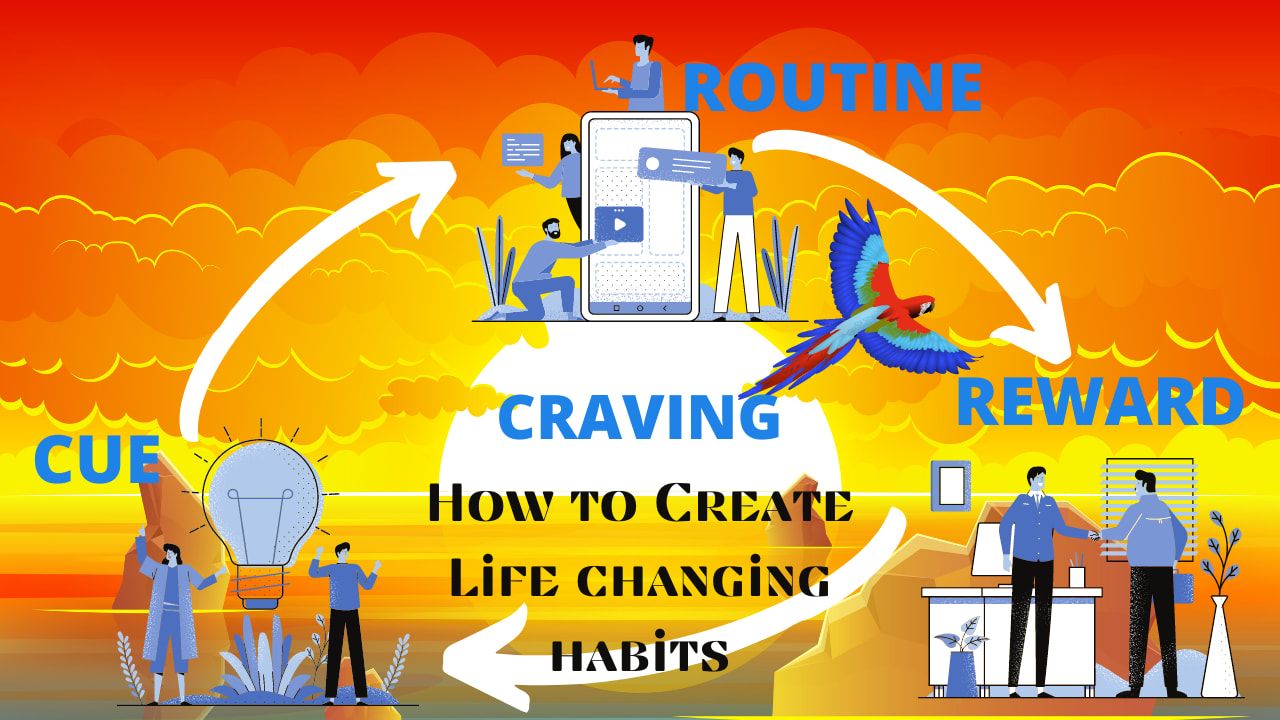How to create life-changing habits?

We all have habits. Some are helping us grow, and some we are not so proud of. Can we really control our habits? In other words, can we create good habits and break bad ones at our will? Let’s try to understand the process behind habits by exploring the contents of two books: The Power of Habit by Charles Duhigg and Atomic Habits by James Clear.
Let’s first understand how habits work. Charles describes in his book that in the center of our brain there is a region called ‘basal ganglia’. This is responsible for storing our habits. Its central location in our brain suggests that it was developed earlier during evolution. Our brain, at any given time, has to perform numerous tasks. To avoid overload, our brain is constantly looking for ways to save efforts. So, the brain converts some sequence of actions into automatic routines, which is the root behind habit creation. Since not every sequence of actions should be automated, our brain has developed a clever way to determine when to let the habits take over.
Charles and James identify the three critical parts of habits: Cue, Routine and Reward. A cue is something that triggers the habit. It can be almost anything from a visual trigger to a certain place, a time of day, an emotion, a sequence of thoughts, or the company of particular people. When the brain observes the cue, it completely stops participating in the decision-making process. The control goes to the basal ganglia and the ‘routine’ is performed. Routine can sometimes be incredibly complex or extremely simple. However, the habits don’t stop there. The last part is the most essential. The reward. The reward can be in the form of physical sensations or emotional payoffs. When the brain receives the reward, it takes back the control from our automated routine. James also describes ‘craving’ as the fourth essential part of habits. However, according to Charles, ‘craving’ is created because of the rewards. Both authors agree that ‘craving’ is an essential ingredient of habits. Let’s understand these ingredients in more detail.
Cue: This is where the habits are triggered. So, to create new habits, we have to figure out what will work as the cue. James suggests using our environment for it. For example, to create a habit of running, we should put the running shoes in such a place that makes it easy to see during our morning routines. Another way is to use the concept of stacking habits. The end of the first habit routine can work as the cue for the next habit to begin. So, the next habit is already in the routine part. Charles provides the example of Michael Phelps to describe how he uses his specific routine on the race day before the race, so performing well in the race just becomes another step. Similarly, to break bad habits, we have to first identify the cues and remove them. Think about the things we do just before our habits. Once we find such cues, we can try to remove them. This has worked well for me. I have never missed my morning stretches after I started putting my fake mat next to my bed. Also, the amount of time I spend on the Facebook app is greatly reduced just by removing the app from the home screen and turning off the notifications.
Routine: This is the habit itself. The goal is to record these sequence of moves in our basal ganglia. It takes time to do so. So, all we have to do is motivate ourselves. James suggests a few ideas for that. One is to change our mindset to think I am ‘getting to do’ something instead of ‘having to do’ something. For example, instead of thinking ‘I have to read a book’ think ‘I get to read a book’. Another trick is to combine something we ‘need to do’ with something we ‘want to do’. For example, we can watch YouTube videos while exercising. If we find ourselves procrastinating, we can also use the 2-min rule: Just do the task for the first two minutes. Like, read the first page of the book, and then we are allowed to stop. James claims that more often we will find ourselves not stopping after 2 minutes. A strong will power is needed to develop new habits. The good news, as Charles mentions in his book, is that the will power is like a muscle which can be trained.
Reward: The reward is critical. It creates the neurological craving that drives the habit. The goal is to produce the dopamine that creates the craving. We can have a glass of smoothie after exercising and the craving for that will help us exercise more. Usually, simple tracking, like putting a cross on the calendar, can also work as a good reward. I use an app that reminds me to drink water. Here the cue is the notification and the reward is the tracker that moves towards my daily drinking goal. For getting rid of bad habits, we do the opposite. Just kidding, we don’t have to punish ourselves. Instead, we identify the reward and get that same reward by some other activity. For example, according to Charles, often when we go to drink coffee at our workplace, we are not really craving coffee or food. We just want to take a break and talk to someone. If we instead just walk to the desk of our coworker and talk to them, our craving is satisfied, and we don’t need to drink coffee for that. We have to create different hypothesis about what is it that we are craving and test them out.
Both authors describe a few things besides the process of habit creation. James talks a lot about the importance of small changes over a long period of time. Often, the small changes provide little reward in the beginning. Which is why it is harder to develop new habits. He refers to this as the valley of disappointment. We have to train our brain to understand that the small changes accumulate the benefits and the growth is exponential. So, even if it is small in the beginning, it will catch up and over the time we will see a big difference.
He describes the concept of identity, process, and outcomes. Most people focus on the outcomes and then design a process to get those outcomes, which leads to changes in their identity. Instead, he suggests going the other way around. Focus on the identity. For example, think ‘I am a productive person, so I must avoid procrastination’ which would result in getting things done. He suggests focusing on ‘systems’ instead of ‘goals’ because the goals only provide momentary satisfaction, and we limit our happiness by attaching it to whether we have achieved the goal or not. Instead, the system focuses on the identity and the process.
Charles, in his book, explores some other interesting topics as well. He describes how the habits are created and used effectively in an organization. How they play the key role in keeping the organization intact. The concept of keystone habits that lead to a big difference in an organization through chain reactions. He describes how a focus on safety rules led to huge organizational changes in a company. He also expands on the habits of a society. How they are created through strong ties, spread through weak ties and self-propel. These habits have an entirely different structure compared to habits of an individual.
Overall, we need to create a plan that incorporates the cue, routine and the reward. This can be used to create new habits and to get rid of bad habits. Given the fact that the habits can be created and modified, it is our responsibility to get rid of our bad habits. We can’t use our bad habits as an excuse to justify its consequences. Charles wrote an entire chapter in his book to discuss this.
This was my attempt to summarize the two books, The Power of Habits and Atomic Habits. I could only scratch the surface of those books in this post. The books go much deeper into those topics.
Recommend a book if you like me to read and write a short review about it. Also, don’t forget to subscribe.
